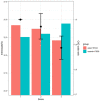Genetically determined intelligence and coronary artery disease risk
- PMID: 32740755
- PMCID: PMC7862508
- DOI: 10.1007/s00392-020-01721-x
Genetically determined intelligence and coronary artery disease risk
Abstract
Background: Epidemiological studies have shown inverse association between intelligence and coronary artery disease (CAD) risk, but the underlying mechanisms remain unclear.
Methods: Based on 242 SNPs independently associated with intelligence, we calculated the genetic intelligence score (gIQ) for participants from 10 CAD case-control studies (n = 34,083) and UK Biobank (n = 427,306). From UK Biobank, we extracted phenotypes including body mass index (BMI), type 2 diabetes (T2D), smoking, hypertension, HDL cholesterol, LDL cholesterol, measured intelligence score, and education attainment. To estimate the effects of gIQ on CAD and its related risk factors, regression analyses was applied. Next, we studied the mediatory roles of measured intelligence and educational attainment. Lastly, Mendelian randomization was performed to validate the findings.
Results: In CAD case-control studies, one standard deviation (SD) increase of gIQ was related to a 5% decrease of CAD risk (odds ratio [OR] of 0.95; 95% confidence interval [CI] 0.93 to 0.98; P = 4.93e-5), which was validated in UK Biobank (OR = 0.97; 95% CI 0.96 to 0.99; P = 6.4e-4). In UK Biobank, we also found significant inverse correlations between gIQ and risk factors of CAD including smoking, BMI, T2D, hypertension, and a positive correlation with HDL cholesterol. The association signals between gIQ and CAD as well as its risk factors got largely attenuated after the adjustment of measured intelligence and educational attainment. The causal role of intelligence in mediating CAD risk was confirmed by Mendelian randomization analyses.
Conclusion: Genetic components of intelligence affect measured intelligence and educational attainment, which subsequently affect the prevalence of CAD via a series of unfavorable risk factor profiles.
Keywords: Coronary artery disease; Educational attainment; Genetic association; Genetic risk score; Intelligence; Obesity; Smoking.
Conflict of interest statement
The authors declare that they have no conflict of interest.
Figures





Comment in
-
No adequate evidence indicating hypertension as an independent risk factor for COVID-19 severity.Clin Res Cardiol. 2021 Jan;110(1):146-147. doi: 10.1007/s00392-020-01653-6. Epub 2020 Apr 23. Clin Res Cardiol. 2021. PMID: 32328736 Free PMC article. No abstract available.
References
Publication types
MeSH terms
Grants and funding
LinkOut - more resources
Full Text Sources
Medical
Miscellaneous

